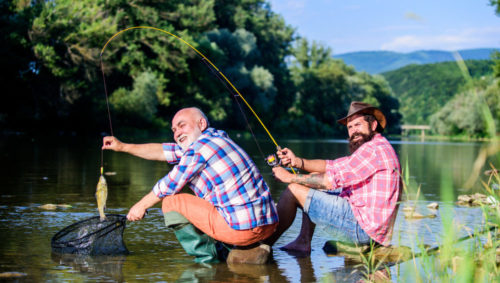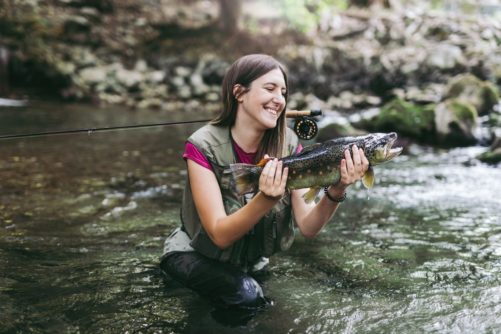Give a Man a Fish and He Will Eat for Today. Teach a Man to Fish and He Will Eat for a Lifetime.
Give a Man a Fish and He Will Eat for Today. Teach a Man to Fish and He Will Eat for a Lifetime.
Which is our Current Approach to Helping Those with Substance Use Disorders?
The Why’s of Substance Use Disorder
For decades those in the field of substance use disorder treatment ascribed to the notion that if we could get people through the doors of treatment, and teach them the skills and tools of sobriety, we were sending people out into the world with most of what they needed to be successful.
We taught people not only the basics of addiction and recovery, but through groups and education we covered:
- relapse prevention skills
- importance of social and family connection
- how to develop a healthy sense of spirituality
- co-occurring disorders through best practices like Cognitive Behavioral Therapy
- Motivational Interviewing to help us identify and connect with individuals
We helped people understand the “why’s” of substance use disorders, like why they made the choices they made that lead them down the road of addiction. This was not about judgement or moral failure, but simply to help them make sense of how they ended up hitting some sort of “bottom.” As professionals, we learned how to effectively communicate with clients, and to create opportunities for them to embrace change.

Essentially, we were teaching people how to “fish” in recovery. We believed that if we could help individuals break free from the bondage of substance use—to believe that a new and different lifestyle was possible—then they could create a life beyond their wildest dreams. That promised life wasn’t about fame or fortune, but rather about living a life that is shared by the rest of the world, becoming a productive member of society.
A life that:
- has ups and downs
- is inclusive of healthy people places and things
- that doesn’t put them in legal jeopardy
- that doesn’t put their lives and the lives of others at risk
- that allows them to be the parents to children that they always wanted to be
- that is not full of lying, cheating and deception
- that returns self-respect and opens the door of opportunity for the respect of others
It was wonderful being a teacher of fisherman and fisherwomen. The parallel process allowed us, the teachers, to take humble pride in our noble profession.
The opioid epidemic has ravished our country. It has stolen lives far too soon. Between opioid deaths, and the legalization of marijuana, we are in the process of losing a generation, and perhaps generations to come.
Harm Reduction Is Dangerous
Insert harm reduction advocates. Many well-intentioned and smart professionals have taught me that there are many roads to recovery, but back in the day, recovery always meant the same thing—a fulfilled life, free from addiction. 12-step programs speak of people in recovery being able to have a life beyond their comprehension or “a life beyond my wildest dreams.” The life is open and available to everyone seeking recovery- even those on Medication Assisted Therapies (MAT). As long as people were living meaningful and purposeful lives who are we to judge an individual’s recovery? But it requires a commitment to recovery. It requires sacrifice and work. Our current approach to harm reduction all but eliminates the work and commitment. The message appears to be we will meet you where you are at, and if you are not ready to commit to the work necessary, we will just keep you alive. Unfortunately, the more we have made these approaches available we have only seen increases in overdose deaths.
Our current harm reduction approach finds that pushing people towards treatment lacks compassion for the individual user. A best practice in professional treatment is Motivational Interviewing. The goal of Motivational Interviewing is to assess an individual’s motivation to change, and incorporate strategies to increase one’s readiness to change. The goal of this best practice is to help people enter an “action” phase, where they are actually engaged in the changes necessary to overcome substance use. Therefore, we may be lacking compassion, lacking will, lacking faith that individuals are capable of change and accepting a deadly status quo and lifestyle of existence through continued substance use.
Unfortunately, the recovery goal posts have continued to move to the detriment of individuals and society. Recovery no longer has any type of empirical definition, but rather is defined by the individual. This quote was taken directly from the language in the New York State Office of Addictions Services and Supports Standards for Certified Programs: “A person may be in remission from their substance use disorder and still use substances.”
This stance promotes a lifestyle in which we invest money in treatment, but at the end of the day, we are advocating to give people a fish, and it’s up to individuals to decide whether they want to learn how to be fisherman. Can you see how this approach keeps can keep people involved in the lifestyle of use?
Existing Instead of Living
Let’s see this in action. Recently I went into run a group with women. As I was walking in, I overheard a conversation about the substances they were going to use after they got out of rehab. When I questioned them about it, they said, “Dave, you don’t understand. Our outpatient programs don’t care if we use, as long as we don’t overdose.”
Is the concept of sobriety dead? My biggest fear and concern regarding harm reduction is that we are giving people permission to stay stuck in lives that lack meaning and purpose. In this lifestyle, individuals are merely existing, continuing with the status quo, which eventually gives way to further consequences that are deadly.
In failing to develop fishermen and women, we fail to engage people in understanding that there is a purpose in their use. Allowing individuals to continue using “less harmful” substances fails to recognize that problematic use is the result of some core issues such as:
- trauma
- depression
- anxiety
- undiagnosed mental health condition
- low self-esteem
Permissiveness of continued substance use allows the individual to continue to seek comfort through self-medication, rather than address the core issue that caused the problematic use! Further, remember when we would discuss marijuana as a gateway drug? Did that somehow disappear with legalization? My 30+ years of experience working with individuals who have overdosed or simply returned to treatment after a relapse is filled with stories of people who have tried to use substances safely, but it ultimately led to a return to their substance of choice. Why? Because we weren’t successful at creating fisherman and fisherwomen, or the individuals that we put our efforts into helping weren’t interested in becoming fisher people, but wanted to be given respite—a fish for today, with every intention of continuing use only to return to treatment and support to get another fish.
I hear the calls of harm reduction folks. They believe we need to meet people where they are at, and it is respectful and compassionate to allow people to decide what they want for themselves. But I fear this comes at a great cost. Former Congressman Patrick Kennedy who is a champion for parity in behavioral health was quoted as saying: “Meet people where they are at, but don’t leave them there.” When we open safe injection sites and hear calls to de-criminalize drugs like heroin, we are increasing the number of people looking for a fish today, and decreasing the number of people willing to become fisher people.
We Can Do Better!
In the state of Oregon, they have decriminalized drugs like heroin and methamphetamines, and they increased funding for treatment. What has this experiment yielded? In 2022, drug overdoses were up nearly 34%, and they have fewer people entering treatment. This type of compassion is meeting people where they are at and unfortunately leaving them there.
Harm reduction proponents will tell you that coerced treatment doesn’t work. Should this apply to teens who don’t want to go to school? Should we demonstrate compassion and provide work opportunities for 13-year-olds who don’t feel like attending school? We don’t do this because we know that chances for a successful independent life increase significantly for those who complete high school. We are providing education to help them become fisherman.
Total abstinence provides the best opportunity for individuals to engage in life. When sober individuals learn that they can overcome life’s obstacles without drinking or drug use it reinforces a “can do” attitude regarding the decision to stay sober, and fuels the desire to continue on a sober path. There are tens of thousands of people that celebrate their sobriety. Whether it came through professional treatment, 12-step programs like Alcoholics Anonymous or Narcotics Anonymous or any other program of support, people emerge as fishermen and women who developed the skills and tools to nourish themselves physically, emotionally and spiritually. That is the goal of recovery.

Our field has got to do better. The notion that giving people a fish for the day through our tacit approval of continued substance use ultimately may be lacking faith in people’s ability to change and to make better choices. In doing so, we are investing millions of tax payer dollars while watching overdose deaths rise. We can’t blame Fentanyl on the increased overdoses, while we are approving individuals continued use. I believe when we begin to urgently help move towards sobriety, that will mark the point in which we will see overdose deaths decrease. Instead, we offer people Fentanyl test strips to use more safely, banking on a substance user to delay getting high to see if their supply is tainted.
Additionally, drug dealers and cartels are always one step ahead! We are already seeing new illicit and powerful drugs emerge are not responsive to Narcan, the opioid blocker used to save people from overdoses. These drug dealers and cartels lack any sense of humanity, and they don’t care that overdose deaths are rising. They prey on the harm reduction model. Keeping people engaged in the lifestyle of use plays right into their hands. We are robbing people of a experiencing a life beyond their wildest dreams. Please! Let’s work to develop more fishermen and women through sobriety and stop playing Russian Roulette with the lives of our children, husbands, wives, mothers and fathers. Permissiveness regarding substance use only serves to delay deadly consequences.